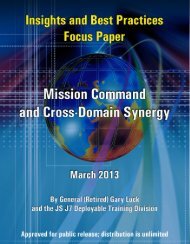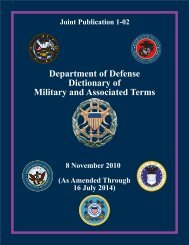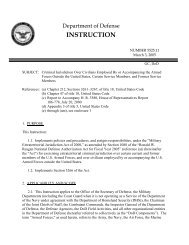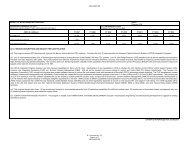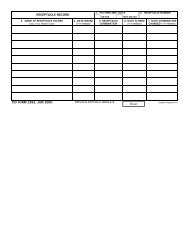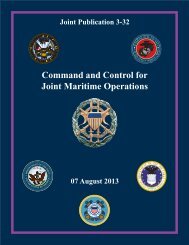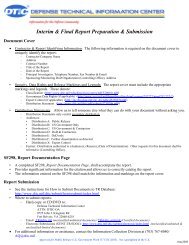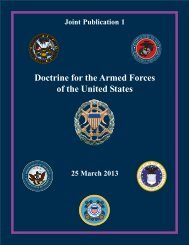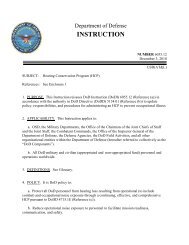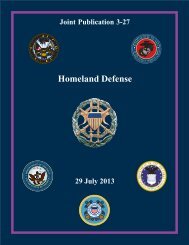JP 3-16, Multinational Operations - Defense Technical Information ...
JP 3-16, Multinational Operations - Defense Technical Information ...
JP 3-16, Multinational Operations - Defense Technical Information ...
You also want an ePaper? Increase the reach of your titles
YUMPU automatically turns print PDFs into web optimized ePapers that Google loves.
Planning and Execution Considerations<br />
Notional Operation Plan Phases<br />
Plan Phases<br />
Level of Military Effort<br />
Phase 0<br />
Shape<br />
Phase I<br />
Deter<br />
Phase II<br />
Seize<br />
Initiative<br />
Seizing the<br />
Initiative Activities<br />
Phase III<br />
Dominate<br />
Dominating<br />
Activities<br />
Phase IV<br />
Stabilize<br />
Enabling Civil<br />
Authority<br />
Activity<br />
Stabilizing<br />
Activities<br />
Phase V<br />
Enable<br />
Civil<br />
Authority<br />
Phase 0<br />
Shape<br />
Deterring Activities<br />
Shaping Activities<br />
Theater<br />
Shaping<br />
Global<br />
Shaping<br />
OPLAN<br />
Approval<br />
OPORD<br />
Activation<br />
OPORD Execution<br />
OPORD<br />
Termination<br />
Legend<br />
OPLAN<br />
operation plan<br />
OPORD<br />
operation order<br />
Figure III-10. Notional Operation Plan Phases<br />
(2) Transitions between phases are designed to be distinct shifts in focus by the<br />
MNF, often accompanied by changes in command or support relationships. The activities<br />
that predominate during a given phase, however, rarely align with neatly definable<br />
breakpoints. The need to move into another phase normally is identified by assessing that a<br />
set of objectives is achieved or that the enemy has acted in a manner that requires a major<br />
change in focus for the joint force and is therefore usually event driven, not time driven.<br />
Changing the focus of the operation takes time and may require changing commander’s<br />
objectives, desired effects, measures of effectiveness, priorities, command relationships,<br />
force allocation, or even the design of the OA. An example is the shift of focus from<br />
sustained combat operations in the dominate phase to a preponderance of stability operations<br />
in the stabilize and enable civil authority phases. Hostilities gradually lessen as the joint<br />
force begins to reestablish order, commerce, and local government and deters adversaries<br />
from resuming hostile actions while the US and international community take steps to<br />
establish or restore the conditions necessary for long-term stability. This challenge demands<br />
an agile shift in joint force skill sets, actions, organizational behaviors, and mental outlooks,<br />
and interorganizational coordination with a wider range of interagency and multinational<br />
III-51



